Regional Jewelry of sindh
Regional Jewelry of Sindh - Introduction
Regional Jewelry of Sindh is a vibrant and integral part of Sindh's rich cultural heritage, reflecting the region's unique artistic and aesthetic sensibilities. Here we are giving a refined overview of traditional jewelry ornaments that are common across Pakistan and the South Asian region (India, Pakistan, Bangladesh), with a focus on distinguishing features specific to Sindh.
A traditional type of jewelry is called Dhuri, Duhri or Duri. Dhuri jewelry is a part of traditional Sindhi cultural jewelry, and while the necklace is a prominent piece, the term 'Dhuri' refers to a broader style of jewelry that includes other matching accessories often worn together, particularly during important cultural events like weddings. It represents the rich heritage and craftsmanship of Sindh.

Regional Jewelry of Sindh - Headpieces
Tikka
- Common Across South Asia: A forehead ornament worn by women, typically featuring a central pendant that rests on the forehead, often attached to the hair with a chain.
- Sindhi Distinction: In Sindh, tikkas are often larger and more ornate, incorporating traditional Sindhi craftsmanship with heavy gold work, vibrant enamel, and sometimes colorful gemstones reflecting local aesthetics. The design often features geometric patterns or floral motifs unique to Sindhi art.
Matha Patti
- Common Across South Asia: An elaborate headpiece covering the forehead, extending from one side of the head to the other, often decorated with intricate gold work, pearls, or stones.
- Sindhi Distinction: Sindhi Matha Patti tends to be broader, with heavier detailing that reflects the region's affinity for bold and intricate designs. The use of Sindhi enamel work (Meenakari) in vibrant colors is more prominent, setting it apart from the simpler versions found in other regions.
Jhoomar
- Common Across South Asia: A side headpiece, worn on the left side, typically used in bridal attire.
- Sindhi Distinction: The Sindhi Jhoomar often features a unique fan-like shape and is decorated with traditional Sindhi patterns, including floral or geometric designs, often with enamel inlays or small pearls, making it distinctively Sindhi in appearance.
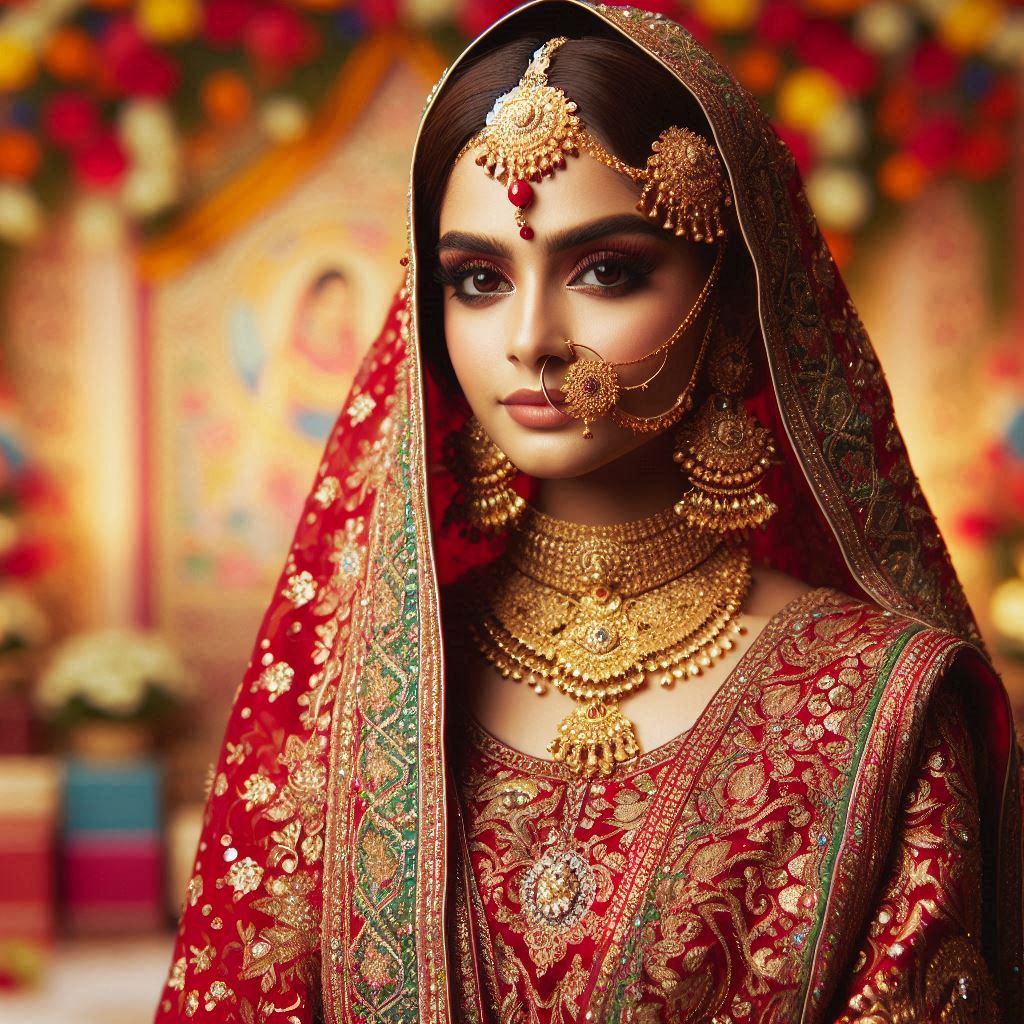 Tikka
Tikka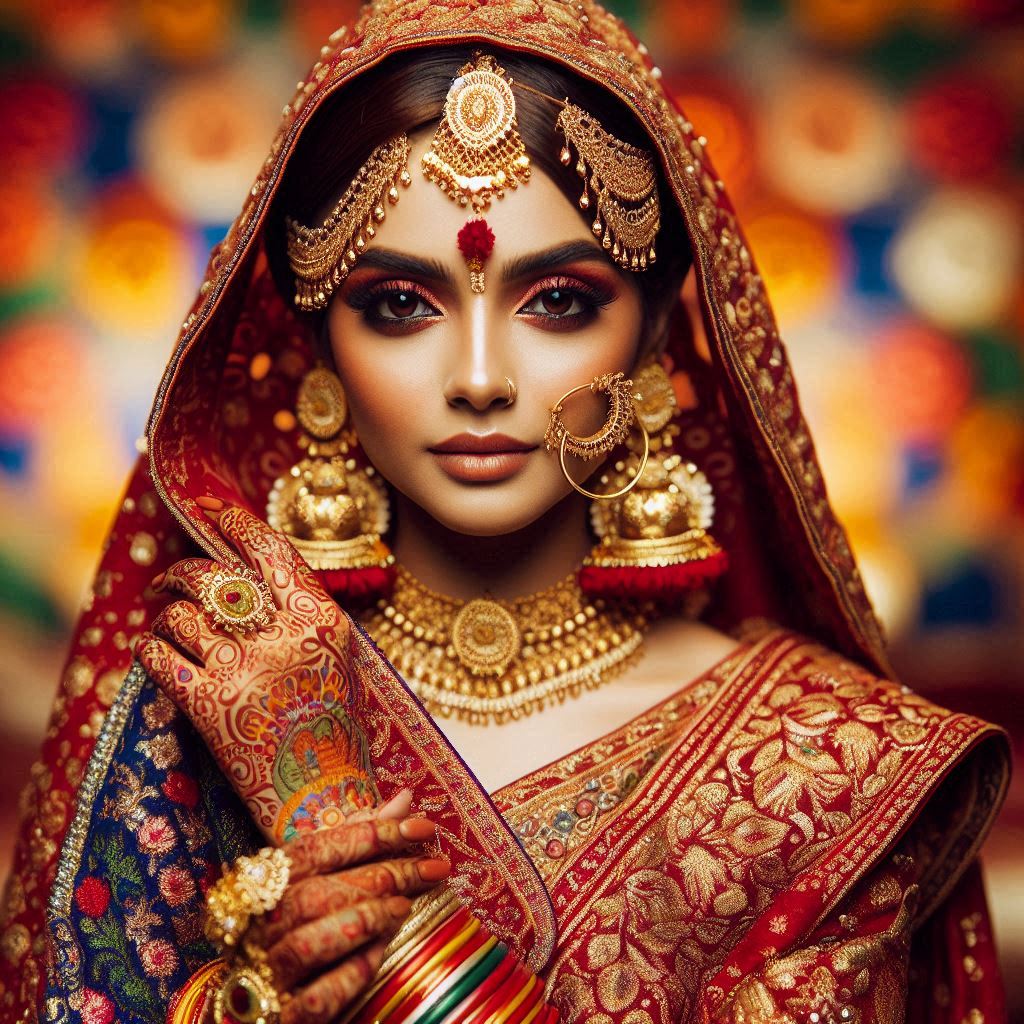 Jhoomar
Jhoomar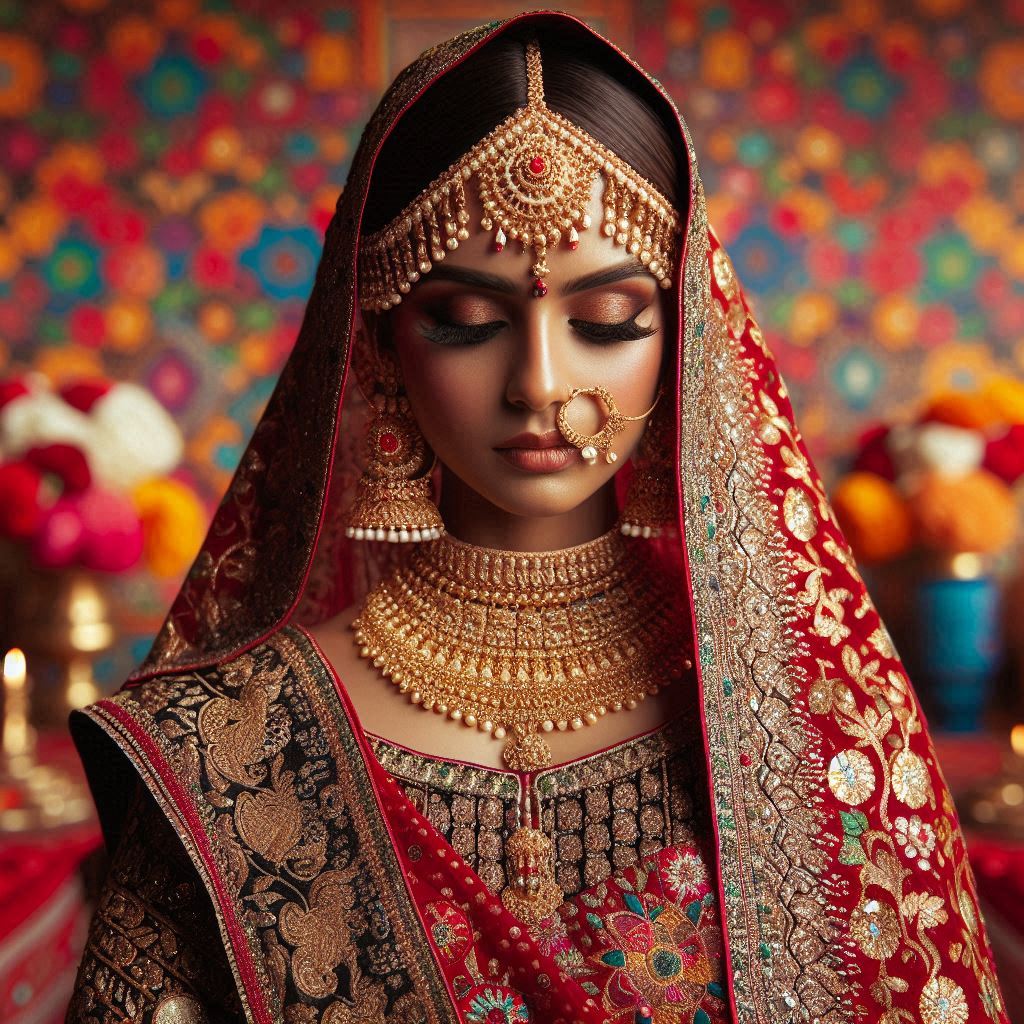 Matha Patti
Matha PattiRegional Jewelry of Sindh - Earrings
These earrings not only highlight the beauty of traditional Sindhi jewelry but also showcase the region's unique craftsmanship, distinguished by its use of enamel work, intricate designs, and bold, vibrant colors.
Karanphool
- Common Across South Asia: Karanphool, meaning "flower of the ear," are large, floral-patterned earrings often worn during weddings or festive occasions.
- Sindhi Distinction: Sindhi Karanphool earrings tend to be larger and more elaborate, featuring intricate filigree work and vibrant enamel inlays. The floral design is often inspired by traditional Sindhi motifs, with an emphasis on bold and colorful aesthetics.
Latkan
- Common Across South Asia: Latkan refers to earrings with hanging tassels or chains, often adding a playful and elegant touch to the overall design.
- Sindhi Distinction: Sindhi Latkan earrings are known for their intricate tassels made from gold chains, beads, or pearls. The design may also incorporate vibrant colors through enamel work, with the tassels being longer and more detailed, reflecting the region's love for elaborate jewelry.
Chandbali
- Common Across South Asia: These crescent moon-shaped earrings are often adorned with intricate filigree work and embedded with stones or pearls.
- Sindhi Distinction: In Sindh, Chandbalis are typically larger and more ornate, often featuring detailed enamel work (Meenakari) in vibrant colors. The crescent may also be accompanied by additional dangling elements like pearls or beads, adding to their grandeur.
Bali
- Common Across South Asia: Bali refers to hoop earrings, which can range from simple, thin hoops to more elaborate designs with embellishments.
- Sindhi Distinction: Sindhi Bali is usually thicker and more intricately designed, often featuring engraved patterns or enamel work. They might also have small pendants or dangling ornaments that reflect Sindhi artistic preferences.
Jhumar Jhumkas
- Common Across South Asia: These are a variation of the classic jhumka, featuring multiple layers of bell-shaped earrings that create a cascading effect.
- Sindhi Distinction: Sindhi Jhumar Jhumkas are often characterized by their size and the number of layers. They are usually more elaborate, with detailed enamel work and vibrant colors. The design might include additional embellishments like small pearls or colored stones, giving them a distinctively rich and traditional appearance.
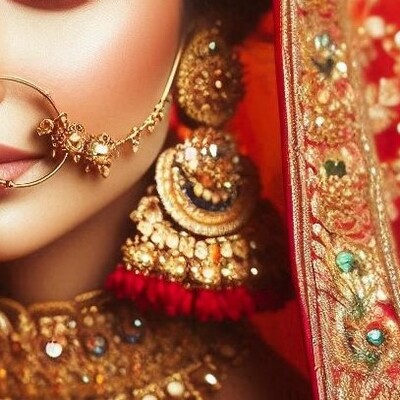 Karanphool
Karanphool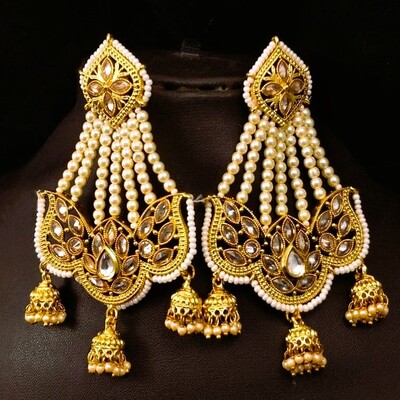 Jhoomar Jhumkay
Jhoomar Jhumkay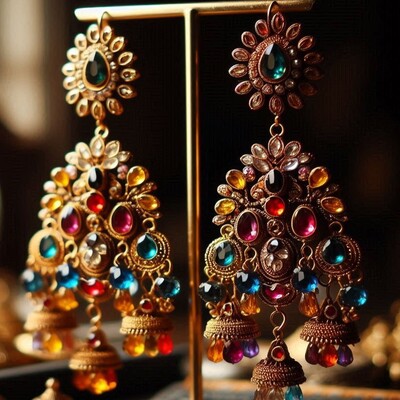 Latkan
LatkanRegional Jewelry of Sindh - Necklaces
These necklaces reflect the unique cultural heritage of Sindh, where jewelry is a blend of tradition, artistry, and vibrant color. The intricate designs, use of enamel, and bold patterns distinguish Sindhi jewelry from similar pieces found elsewhere in South Asia.
Hansli
- Common Across South Asia: A rigid, curved necklace, usually made of gold or silver, that sits close to the collarbone.
- Sindhi Distinction: In Sindh, Hansli is often more elaborately designed, with engraved patterns or embossed motifs reflecting traditional Sindhi art. It is typically heavier, with the use of gold or silver in solid form and may feature enamel inlays that are unique to the region's jewelry-making techniques. This ornament is popular in Saraiki and Balochi cultures as well
Guluband
- Common Across South Asia: A choker-style necklace that sits tightly around the neck, often adorned with intricate patterns or gemstones.
- Sindhi Distinction: In Sindh, the Guluband is often larger and crafted from heavy gold or silver, with intricate filigree work. It may feature Meenakari (enamel) designs in bold colors such as red, green, and blue, reflecting Sindhi cultural preferences. The design might also include small dangling pearls or beads for added richness.
Ras Mala
- Common Across South Asia: A long necklace with spherical beads or pearls, often used as a bridal ornament.
- Sindhi Distinction: The Sindhi Ras Mala incorporates large gold beads mixed with pearls or colorful gemstones. The beads are intricately carved with traditional Sindhi designs, and the necklace often features small dangling ornaments at the base, giving it a more decorative and traditional feel.
Taweez Haar
- Common Across South Asia: A necklace featuring a rectangular or cylindrical pendant, often inscribed with protective symbols or texts.
- Sindhi Distinction: In Sindh, the Taweez Haar often includes bold, intricate engravings on the pendant, and the chain is usually made of gold or silver. The pendant may also feature enamel or gemstone accents, making it not just a protective amulet but also an ornamental piece. The design may be inspired by Sindhi folklore or religious symbolism.
Mundri Haar
- Common Across South Asia: A traditional necklace that is characterized by a series of connected rings or circles.
- Sindhi Distinction: Sindhi Mundri Haars are typically more elaborate, featuring engraved designs on each ring or circle, often with enamel highlights. The connecting chains may include small dangling ornaments, and the rings themselves are usually larger and more detailed compared to versions found in other regions.
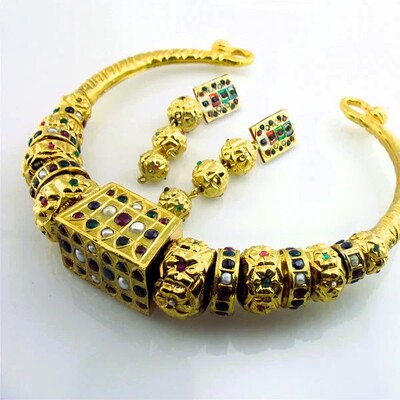 Hansli
Hansli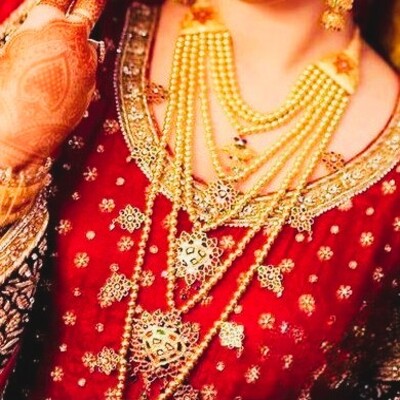 Mundri Haar
Mundri Haar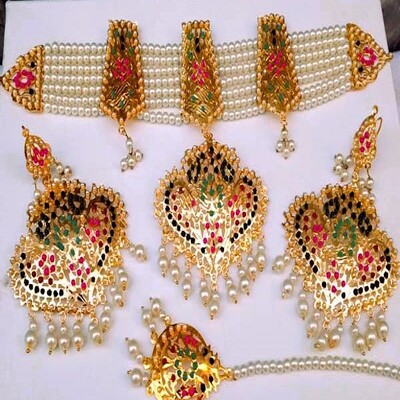 Guluband
GulubandRegional Jewelry of Sindh - Bangles
Churiyan (Bangles)
- Common Across South Asia: Bangles made of gold, glass, or metal, worn in stacks, often associated with marital status.
- Sindhi Distinction: In Sindh, gold bangles are often wider and heavily adorned with intricate carvings or filigree work. Glass bangles from Sindh are known for their durability and vibrant colors, often worn in large quantities to create a jingling sound that is culturally significant.
Hathphool
- Common Across South Asia: A hand ornament connecting a bracelet to rings on the fingers, often worn by brides.
- Sindhi Distinction: Sindhi Hathphool designs are typically heavier and feature intricate filigree work, often with added elements like colored gemstones or beads that reflect Sindhi artistic traditions.
Kara
- Common Across South Asia: A solid bangle, typically made of gold or silver, worn by both men and women.
- Sindhi Distinction: The Sindhi Kara is often broader and more heavily engraved, sometimes featuring religious symbols or local designs that are specific to Sindh. The use of Sindhi enamel work in bold colors is also a distinguishing feature.
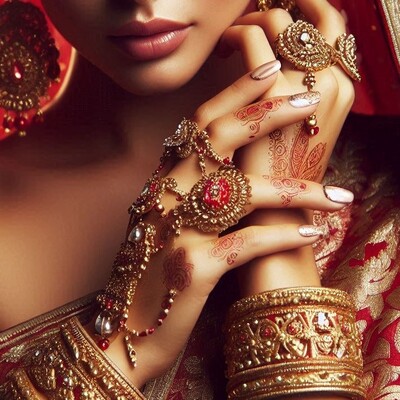 Hathphool & Kara
Hathphool & Kara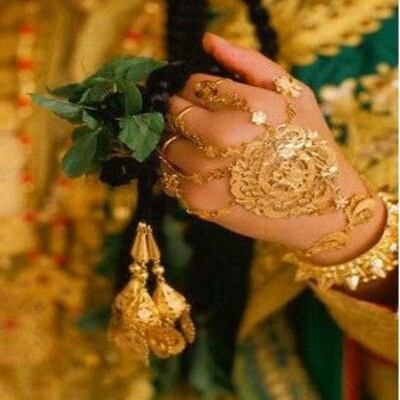 Hathphool & Bangles
Hathphool & Bangles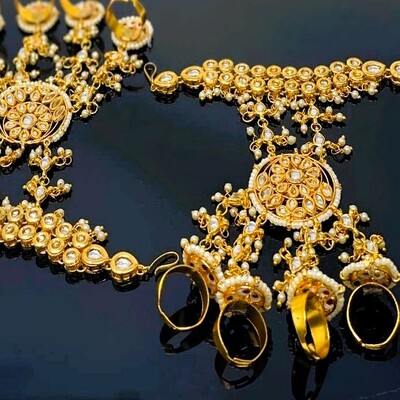 Hathphool
HathphoolRegional Jewelry of Sindh - Anklets (Payal/Pazaib)
Anklets are an essential part of traditional South Asian jewelry, often worn by women in Pakistan and across the Indo-Pak-Bangladesh region. In Sindh, Payal and Pazaib are two main types of anklets that have deep cultural significance. Both are crafted with intricate designs and are often used during weddings or cultural events.
Payal
- Common Across South Asia: Payal is a lightweight anklet, typically made from silver. It is often crafted with delicate chains and sometimes adorned with small bells or charms that produce a soft sound while walking.
- Sindhi Distinction: Sindhi Payals are usually more ornate, featuring intricate filigree work, small beads, and sometimes enamel inlay. The design often incorporates traditional Sindhi patterns, reflecting the local artistry. Payals from this region may also include small dangling elements, like tiny coins or decorative charms, which are symbolic in cultural contexts.
Pazaib
- Common Across South Asia: Pazaib is generally heavier and more elaborate than Payal. It often features multiple chains, thick metal bands, and larger bells or charms. Pazaib anklets are usually made from silver, though gold versions also exist but avoided.
- Sindhi Distinction: In Sindh, Pazaib anklets are larger and more heavily decorated with traditional patterns, often using thick silver chains and bold motifs. Sindhi Pazaibs may include intricate engravings or embossing and are worn as a statement piece, particularly by brides. The anklet is often associated with bridal wear and can be heavily embellished with gemstones, pearls, or small trinkets.
Chandhan
- Common Across South Asia: A variation of Payal, Chandhan features a single broad band, usually adorned with small bell-like attachments that tinkle as the wearer moves. The design may also include floral or geometric motifs that are unique to the region.
- Sindhi Distinction: Chandhan from Sindh is known for its bold craftsmanship, with more attention given to the engraved designs and the arrangement of bells. It's often crafted in silver and worn during special cultural or festive occasions.
Toray
- Common Across South Asia: Toray are traditional ankle ornaments commonly worn in Sindh and other parts of Pakistan. Unlike Payal or Pazaib, which are more delicate and jingling in nature, Toray are heavier and sturdier, often made from thicker silver. They are a more solid form of anklet and are generally simpler in design but sometimes more rustic or bold. Toray tend to be simple but bold, often featuring thick bands or hoops around the ankle. The simplicity in design reflects their more utilitarian nature, as they were originally worn daily by women in rural areas.
- Sindhi Distinction: In Sindh, Toray are associated with traditional attire, particularly in rural communities. The regional distinction lies in the crafting techniques and patterns specific to the area, which often emphasize strength and durability over intricate beauty. In some designs, small motifs inspired by Sindhi folk patterns may be engraved into the metal.
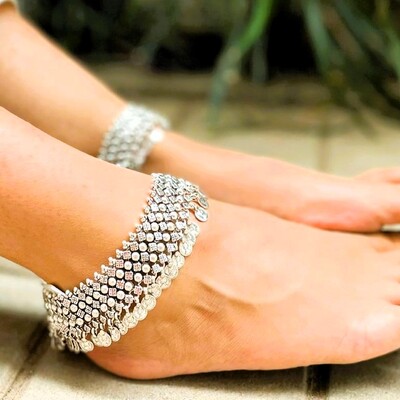 Payal
Payal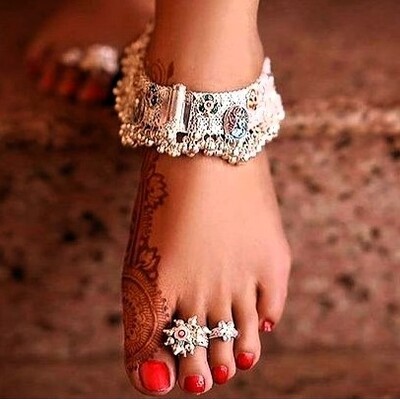 Toray
Toray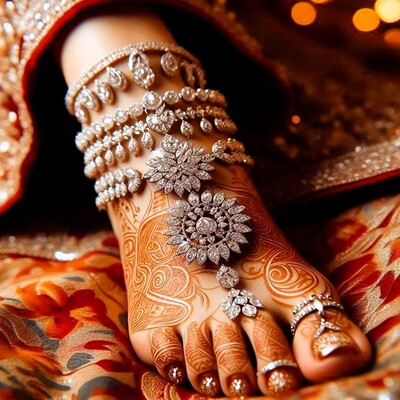 Anklets-Payal, Pazaib & Toe Rings
Anklets-Payal, Pazaib & Toe Rings- Home ›
- Products and Trades ›
- Pakistani Jewelry >
- Regional Jewelry of Sindh


